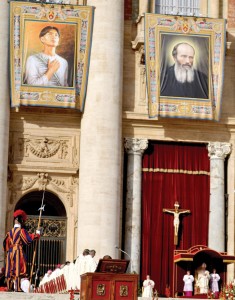
NEW SAINTS The Pope (bottom, right) announces the sainthood of Pedro Calungsod and six other Catholic martyrs in St. Peter’s Square at the Vatican in a Mass marking the start of a “Year of Faith” aimed at countering the rising tide of secularism in the West. AFP
VATICAN CITY—The Philippines got its second saint Sunday with Pope Benedict XVI canonizing the 17th-century teen missionary Pedro Calungsod along with six other martyrs of the Catholic Church in a solemn ceremony at St. Peter’s Square in Rome.
A sizeable crowd of flag-waving Filipinos, expatriates in Italy, who turned out in droves for the ceremony, and a delegation of 5,000 from home, cheered as the Pope declared Calungsod a saint and worthy of veneration by the entire Catholic Church.
“May the example and courageous witness of Pedro Calungsod inspire the dear people of the Philippines to announce the kingdom bravely and to win souls for God,” Pope Benedict XVI said in his homily.
About 80,000 pilgrims from different parts of the world filled St. Peter’s Square for the canonization rites, which started with the head of the Vatican’s saint-making office reading aloud each of the names of the seven new saints in Latin, drawing cheers from the crowd.
“We feel very happy and proud,” said Mariana Dieza, a 39-year-old housekeeper in Italy who joined fellow Filipinos in St. Peter’s Square for the canonization rites and Mass.
“We are especially proud because he was so young,” Dieza said.
The Philippines waited 12 years to get a second Filipino saint. The country’s first saint is Lorenzo Ruiz, who was canonized in 1987.
Vice President Jejomar Binay, representing President Benigno Aquino, who left for state visits to Australia and New Zealand Sunday, led the Philippine government delegation.
Binay said the canonization of Calungsod was important to the Philippines, Asia’s largest Roman Catholic-majority country.
Other new saints
Pope Benedict XVI also canonized six other Catholic martyrs of various nationalities.
- Jacques Berthieu, a 19th-century French Jesuit who was killed by rebels in Madagascar, where he worked as a missionary.
- Giovanni Battista Piamarta, an Italian who founded a religious order in 1900 and established a Catholic printing and publishing house in his native Brescia.
- Carmen Salles y Barangueras, a Spanish nun who founded a religious order to educate children in 1892.
- Anna Schaeffer, a 19th-century German laywoman who became a model for the sick and suffering after she fell into a boiler and badly burned her legs, the wounds never healing and causing her constant pain.
- Kateri Tekakwitha, a 17th-century Mohican who was ostracized and persecuted for converting to the Catholic faith and now the first Native American saint.
- Mother Marianne Cope, a 19th-century Franciscan nun who cared for leprosy patients in Hawaii.
Reviving Christianity
In his homily, the Pope, speaking in Latin, praised each of the seven new saints as examples for the entire Church.
The canonizations coincided with a Vatican meeting of the world’s bishops on ways to revive Christianity in places where it has fallen by the wayside.
Several of the new saints were missionaries, making clear the Pope hopes their example will be relevant today as the Catholic Church tries to hold onto its faithful in the face of competition from evangelical churches in Africa and Latin America, increasing secularization in the West and disenchantment with the Church over the clerical sex abuse scandal in Europe and beyond.
Celebration at home
In the Philippines, thousands of Catholics followed the canonization rites, which began at 9:30 a.m. (about 4 p.m. in Manila) and celebrated Calungsod’s sainthood with Masses, processions, stage plays, religious shows and the launching of postal stamps bearing his image and a map of his journey as a young Catholic missionary to Guam, where he was killed while spreading the Catholic faith 340 years ago.
Celebrations across the Philippines were centered in Metro Manila, Cebu City and in the municipality of Ginatilan in southwestern Cebu, which claims to be Calungsod’s hometown.
Large television screens were installed in church compounds to allow the faithful to watch the canonization rites in the Vatican.
Calungsod’s portraits were displayed in churches and many bought and carried his statues.
Television networks ran documentaries about Calungsod’s life and sainthood, and the country’s leading newspapers published stories of his canonization, portraying him as a model for young Filipinos.
Scarce details
Details of Calungsod’s life are scarce, but according to available Church records, when he and the mission superior, the Rev. Diego Luis de San Vitores, tried to baptize a baby in Tumhon village in Guam on April 2, 1672, the child’s father angrily refused and, with the help of other natives, hacked them both to death and threw their bodies into the ocean.
Many Filipinos living in Rome attended the canonization rites and Mass, which also drew Catholics from nearby Malta.
“He was just a teenager, he was just a boy and he defended the Catholic faith,” Filipino pilgrim Jennifer Icao-Calleja said last week. “It is very important to the youth that at least we have to maintain our faith in God.”